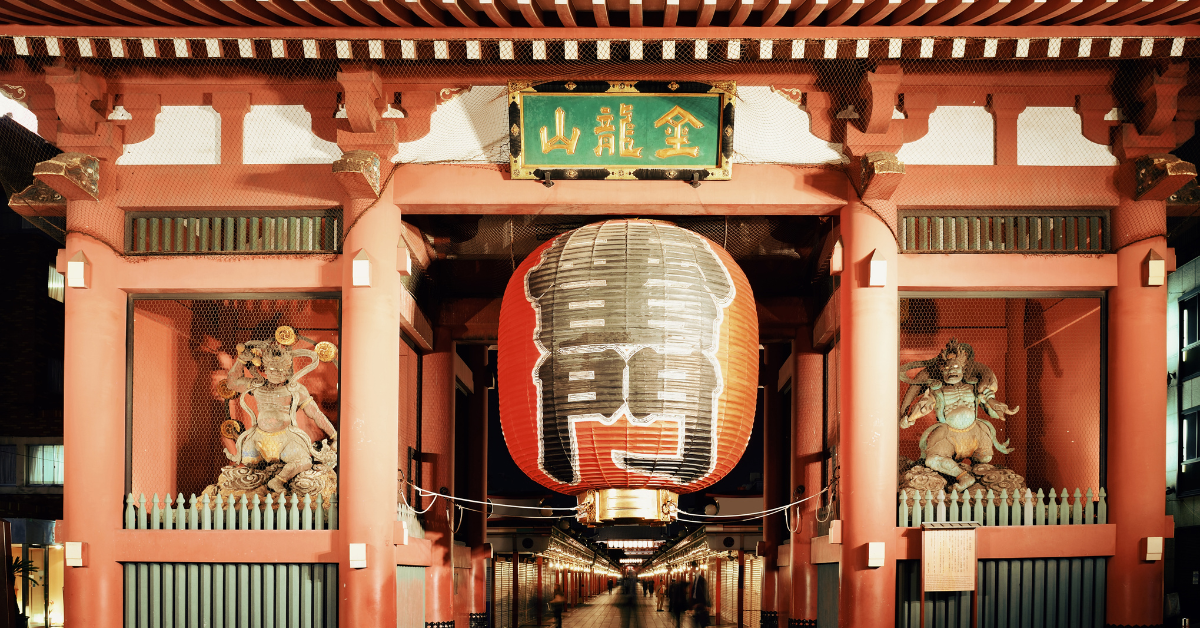Sensoji Temple is one of Tokyo’s most iconic landmarks, offering foreign visitors a gateway into Japan’s ancient spirituality and vibrant culture.
From the majestic Kaminarimon Gate to the lively Nakamise Street and sacred Main Hall, every corner reveals a different facet of Japanese tradition. Whether you’re visiting for prayer, photography, or cultural exploration, Sensoji offers a truly immersive experience.
What is Sensoji Temple?
Sensoji Temple is a Buddhist temple located in Asakusa, Taito City, Tokyo, believed to have been founded in 628 AD. It is one of the oldest temples in Tokyo and has been a sacred place for centuries. Its official name is Kinryuzan Sensoji Temple, and it belongs to the Seikanzeon sect. The temple’s principal deity is Kannon Bodhisattva, known as a figure of compassion who brings peace and strength to those in need.
Sensoji is more than a religious site; it is a cultural treasure filled with historical buildings such as the Kaminarimon Gate, Hozomon Gate, the Main Hall, the Five-Story Pagoda, and the Denboin Garden. These structures have been preserved and restored over time, showcasing the sophistication of traditional Japanese architecture.
Basic Information of Sensoji
| Item | Details |
|---|---|
| Year Founded | 628 AD (Estimated) |
| Sect | Seikanzeon |
| Principal Deity | Kannon Bodhisattva |
| Official Name | Kinryuzan Sensoji Temple |
| Location | 2-3-1 Asakusa, Taito-ku, Tokyo |
| Admission | Free |
The temple complex is both spiritual and welcoming, with multilingual signage, free Wi-Fi, and tourist information services available, making it accessible even to those unfamiliar with Japanese customs.
Highlights of Sensoji
The most iconic highlight is the Kaminarimon (Thunder Gate), with its massive red lantern hanging in the center. The lantern is nearly 4 meters tall and weighs approximately 700 kilograms. Tourists often take pictures here as a must-do.
Beyond the gate lies Nakamise Street, a vibrant shopping avenue about 250 meters long, lined with roughly 90 traditional stores and snack stalls offering everything from souvenirs to street food.
Popular Items at Nakamise Street
| Item | Description | Feature |
|---|---|---|
| Ningyo-yaki | Sponge cake with sweet bean filling | Embossed with the Kaminarimon |
| Folding Fans | Traditional Japanese fans | Great for any season |
| Japanese Goods | Handkerchiefs, pouches, fabric crafts | Stylish and practical |
| Origami | Traditional Japanese paper art | Lightweight, great for gifts |
You’ll reach the Main Hall, where visitors quietly pray to the Kannon Bodhisattva. Next to it stands the Five-Story Pagoda, a stunning architectural piece representing Buddhist harmony and beauty.
Annual Events and Cultural Experiences
Sensoji hosts various cultural and religious events throughout the year. The most famous is Sanja Matsuri, held in May. The streets fill with energy as people carry ornate mikoshi (portable shrines) through the area.
Major Annual Events at Sensoji
| Event | Month | Description |
|---|---|---|
| Sanja Matsuri | May | Largest local festival with mikoshi parades |
| Setsubun | February | Traditional bean-throwing ceremony |
| New Year Visit | January | Millions visit to pray for a good year |
| Hozuki Market | July | Summer market tied to Obon traditions |
| Hagoita Market | December | Decorative paddle fair at year-end |
These events are excellent opportunities to experience Japan’s seasonal traditions, offering a new perspective each time you visit.
Access and Transportation
Sensoji Temple is highly accessible, with multiple train lines converging at Asakusa Station. You can use Tokyo Metro Ginza Line, Toei Asakusa Line, or Tobu Skytree Line. From the station, it’s about a 5-minute walk to the temple grounds.
Estimated Access Time from Major Stations
| Departure Point | Approx. Time | Transfers |
|---|---|---|
| Tokyo Station | 15 min | 1 (via Ginza Line) |
| Shinjuku Station | 25 min | 1 (via Shinjuku Line) |
| Shibuya Station | 35 min | Direct (via Ginza Line) |
The Asakusa area is ideal for walking tours, with nearby attractions such as Tokyo Skytree, Ueno Park, and Kappabashi Kitchenware Street.
Nearby Attractions from Sensoji
| Destination | Walking/Travel Time |
|---|---|
| Tokyo Skytree | 20 min walk or 5 min train |
| Ueno Park | 10 min by train |
| Kappabashi Tool Street | 15 min walk |
| Hanayashiki Amusement Park | 5 min walk |
Manners and Tips for Visiting
As a sacred site, visitors to Sensoji are expected to follow proper etiquette. Begin by purifying your hands and mouth at the water basin, then waft incense smoke over your body to cleanse bad spirits, and finally proceed to the main hall to pray.
Basic Manners at Sensoji
| Action | Description |
|---|---|
| Hand Purification | Rinse hands and mouth to cleanse body and mind |
| Incense | Waft smoke over yourself for good health |
| Offering Prayer | Throw coins, bow, and pray silently |
| Dress Code | Avoid revealing or flashy clothing |
| Photography | Avoid flash, respect other worshippers |
Visitors are also advised to keep quiet, avoid large group chatter, and be mindful of others’ space during busy periods.
Conclusion
Sensoji is more than a sightseeing spot—it is a gateway into Japanese spirituality and tradition. With historic gates, vibrant shopping streets, peaceful prayer spaces, and seasonal events, it provides a comprehensive experience of Japan’s cultural richness.
With excellent access, multilingual support, and a welcoming environment, even first-time travelers can enjoy Sensoji with ease. Whether it’s your first or fifth time in Japan, this temple is a must-visit destination.






